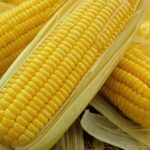 Callus is a patch of hard, thickened skin on the foot that is formed in response to pressure or friction.
Callus is a patch of hard, thickened skin on the foot that is formed in response to pressure or friction.
The domesticated plant Zea mays L. also known as maize. A green, leafy (grain) plant that is one of the world’s largest providers of edible starch and fructose (sugar) for mankind’s use. This summer annual plant varies in height from two feet (0.5 meter) to more than twenty feet (6 meters) tall. The seeds (kernels) are borne in cobs, ranging in size from two feet long to smaller than a man’s thumb.
Grown widely in the world’s temperate zones, com is grown as far north as latitude 58° in Canada and Russia; and as far south as latitude 40° in the Southern Hemisphere. During the 1980’s, scientists were able to insert genes from Bacillus thuhngiensis (B.t.) bacteria into the com plant, to make that plant resistant to certain insects. During the 1990’s, scientists were able to insert genes into the com plant, to make it tolerant to certain herbicides; and to cause the com plant to produce monoclonal antibodies (MAb).
Some of the major economic pests of com include the European com borer (Ostrinia nubialis), com earworm (Helicoverpa zed), com root-worm (Diabrotica virgifera virgiferd).
In North America, the grain characterized by its long, yellow cobs is called corn, a word of Indo-European origin; in England, the same grain is known as maize, a word of Caribbean origin. The different names arose in the early seventeenth century, when the Pilgrims came to their new world: the grains they brought from England and tried to grow in America withered in their new climate, but the kernels generously given to them by the Native Americans flourished. At first, the Pilgrims honoured their Native saviours by calling their new grain Indian corn, the word corn having been used since the ninth century in England as a name for seeds harvested from all grains. By the beginning of the eighteenth century, however, the Americans had dropped Indian from their original name for the yellow-cobbed grain and simply started calling it corn. Meanwhile, in Europe, the yellow-cobbed grain had been completely unknown until it was brought from the Americas in the sixteenth century. The Spanish were among the first to bring this grain back to Europe, having been introduced to it by the Caribs, a people who gave their name to the Caribbean islands where they lived. The Carib word for the grain was marichi, which was rendered into Spanish as maisi and then adopted into English at the end of the sixteenth century as maize.
Horny mass of epithelial cells overlying a bone, usually on the toes and resulting from chronic pressure (e.g., from ill-fitting shoes). Treatment includes paring or peeling of the hard tissue and relief of the pressure.
An area of hard thickened skin on or between the toes: a type of callosity produced by ill-fitting shoes. The homy skin layers form an inverted pyramid that presses down into the deeper skin layers, causing pain. A com may be treated by soaking in hot water or applying softening agents.
A horny induration and thickening of the skin that may be hard or soft according to location. It is usually caused by the pressure or friction from poorly fitting shoes.
In the American region, a term designating a specific type of corn, known as Indian corn or maize. In contrast, across the European continent, the term refers to any of the chief cereal grains, such as wheat, rye, or barley.
The term “corn” is used as a general descriptor for a variety of grains, including wheat, rye, oats, barley, maize, and others. In cooking, “corn” generally refers to sweet corn or maize. Special varieties of corn are grown specifically for this purpose, and they come in ears with white, yellow, or white and yellow kernels, each with its own following of advocates. High-quality corn can be identified by its fresh-looking green husk and brown silk tassel. The ear should be filled with plump, milky kernels that are firm but not hard. Corn that has yellow or dried-out husks or ears with very small, immature seeds should be avoided.
A corn is a small localized area of thickened skin that typically forms on a toe or another part of the foot. It arises due to the pressure exerted by ill-fitting shoes. The accumulation of dead skin cells results in the formation of a hardened plug that extends into the deeper layers of the skin. Pressing on this plug can cause discomfort and pain. To alleviate the pain associated with a corn, a soft, cushioning ring or corn pad can be applied over it to relieve pressure. If the corn persists despite these measures, the thickened skin can be professionally removed by a chiropodist.
A small, painful growth on the skin’s horny layer of the toes, featuring a central core that induces discomfort when pressure is applied. When moisture is a contributing factor, these are referred to as soft corns.
